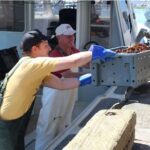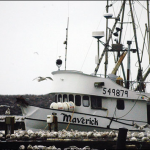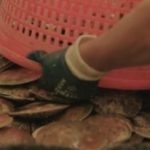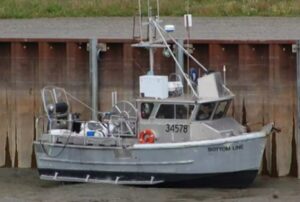Tag Archives: American Lobster Settlement Index
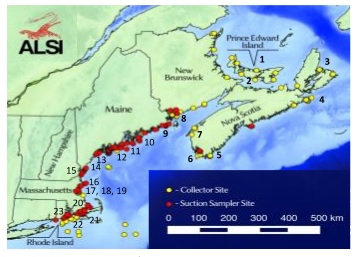
Coast to coast, companies team up to fund UMaine lobster research
A $75,000 gift from two seafood companies will fund a fourth field season for a University of Maine deepwater lobster settlement monitoring program. The deepwater research is an extension of the American Lobster Settlement Index, which was initiated in 1989 by Rick Wahle, a research professor in the School of Marine Sciences and director of the Lobster Institute. The index includes collaborators and monitoring sites from Rhode Island to Newfoundland.,,, The 2019 field season will be funded by a $50,000 gift from Ready Seafood Company, and a $25,000 gift from Santa Monica Seafood Co., a seafood distributor in California. (Thank You!) >click to read<11:42

Discovery of immature lobsters in deep Down East waters may be good news for industry
The discovery of baby lobsters in the deep waters off eastern Maine could be good news for the future of the U.S.’s most valuable fishery. Since 1989, scientists led by University of Maine professor Richard Wahle have looked for baby lobsters at 100 shallow-water test sites from Rhode Island to New Brunswick to monitor the health of this fishery. The number of babies found in the samples started to decline about a decade ago, leading scientists to worry that a population bust may be looming. “We couldn’t find the settlers,” Wahle said Monday. “Increasingly, we found they weren’t showing up where we had always found them.” >click to read<07:42
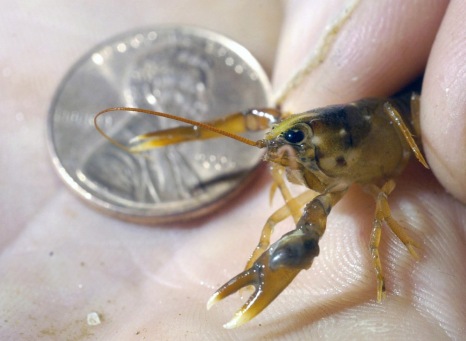
A mystery is born: Where are all the baby lobsters?
Biologists and lobstermen are growing increasingly worried that the state’s most valuable fishery, which in recent years has boasted record volume and value and accounts for more than 80 percent of Maine’s fishing profit, is about to go bust, a doomsday economic scenario some call the curse of the “gilded trap.” At the center of their concern: The number of baby lobsters found in the Gulf of Maine continues to fall. “We call it the great disconnect,” said Joshua Carloni, New Hampshire’s state lobster biologist. “And as you can imagine, it has us concerned.”,,, The Seabrook tows found a decline in copepods – tiny planktonic crustaceans that are most likely a staple of the lobster larval diet click here to read the story 08:14
Fish in the Northwest Atlantic Are Going Hungry – New Science From Maine’s Department of Marine Resources Helps To Explain Why. click here to read the article
American Lobster Settlement Index | Update 2016
 Just as US and Canadian lobster landings seem to be breaking all the records, settlement has been dipping to all-time lows. The disconnect is causing a lot of people to scratch their heads. Harvests on both sides of the border have sustained an almost uninterrupted surge in abundance for more than a decade. By 2015, US harvests had nearly doubled since 2003, and since 2000 for Canada, making for a combined volume of 157 thousand metric tons (346 million lbs) with a value of $US1.48 billion. Fishery independent state and federal surveys leave no doubt that there have been real and dramatic increases in abundance. While the 2016 landings are still being tallied, if Maine’s impressive performance is any indication (Maine harvests about 80% of the US share), 2016 is likely to go down as another banner year both in volume and value. By all indications, the reproductive output of the American lobster population should be greater than ever, but for some reason it does not seem to be translating into record breaking settlement. click here to read the report 10:45
Just as US and Canadian lobster landings seem to be breaking all the records, settlement has been dipping to all-time lows. The disconnect is causing a lot of people to scratch their heads. Harvests on both sides of the border have sustained an almost uninterrupted surge in abundance for more than a decade. By 2015, US harvests had nearly doubled since 2003, and since 2000 for Canada, making for a combined volume of 157 thousand metric tons (346 million lbs) with a value of $US1.48 billion. Fishery independent state and federal surveys leave no doubt that there have been real and dramatic increases in abundance. While the 2016 landings are still being tallied, if Maine’s impressive performance is any indication (Maine harvests about 80% of the US share), 2016 is likely to go down as another banner year both in volume and value. By all indications, the reproductive output of the American lobster population should be greater than ever, but for some reason it does not seem to be translating into record breaking settlement. click here to read the report 10:45
Lobster forecast causes concern, not panic, for Maine’s industry
Maine’s lobster industry, the state’s most lucrative fishery, may foresee shrinking harvests and higher market prices, but such changes are likely several years away, lobstermen and dealers said Wednesday. portlandpress Read more here 11:09




































